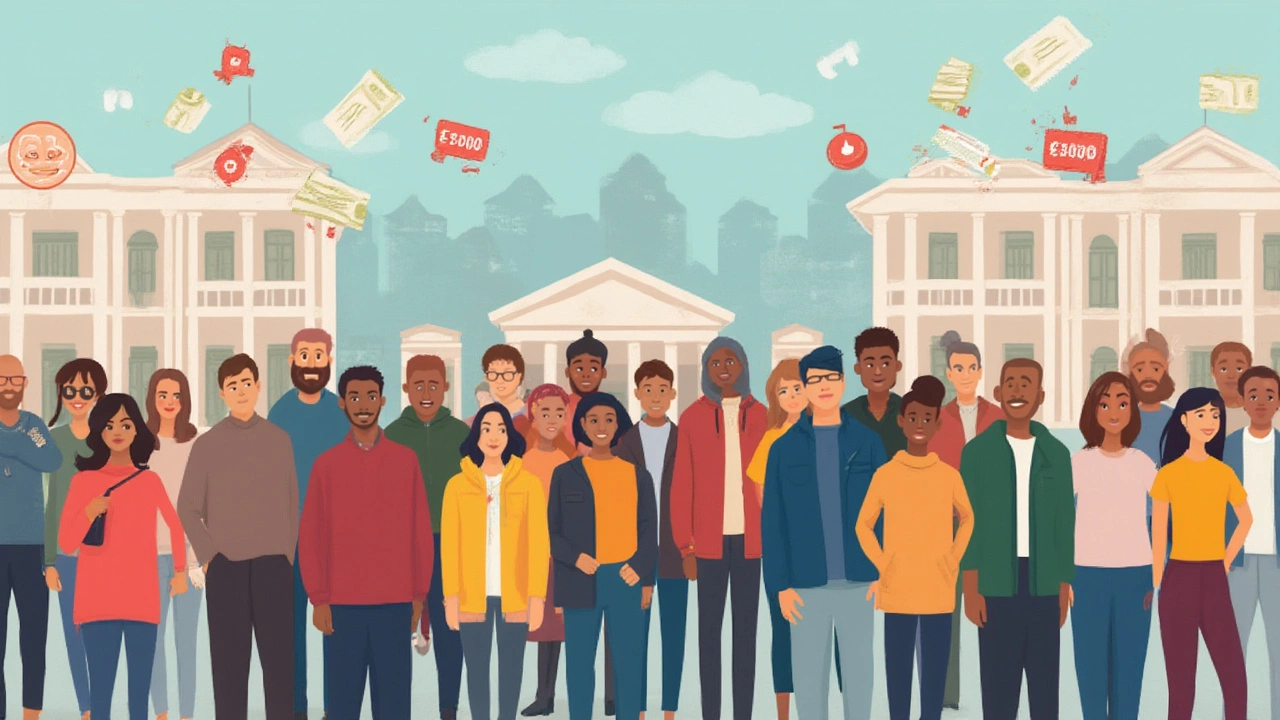Ever felt like you’re stuck in a tug-of-war between your finances and an out-of-nowhere expense? I have. One time, my son Alaric needed braces, my daughter Thalia suddenly outgrew everything, and then my 11-year-old washing machine sputtered its last breath. My calendar was packed, my budget stretched thin, and my sleep schedule? Nonexistent. Like a lot of people, the idea of borrowing $10,000 for peace of mind sounded tempting — and honestly, a tad overwhelming. Is it actually that hard to qualify for a $10,000 personal loan these days, or is half the internet just being dramatic? Let’s dig in, get personal, and see what lenders are really sizing up when you apply for a loan like this.
What Lenders Really Look At When You Apply for $10,000
First things first: $10,000 isn’t chump change. Banks, credit unions, and online lenders treat it as a serious commitment. It’s not like getting a new credit card for daily coffee runs or grabbing a “buy now, pay later” couch. But “hard” is relative; whether you’ll face a tough approval depends squarely on your details — not just random luck. What really matters? Let’s lift that curtain.
The first big gate is your credit score. Lenders use it to measure risk, predicting how likely you are to pay them back without drama. As of 2025, most mainstream lenders want to see a minimum score of about 600 for basic personal loans, but for $10,000, many raise the bar closer to 660 or even 700. If your history is rocky from missed payments or wild credit card balances, yes, things get trickier. But there’s wiggle room: if you apply at a local credit union, for example, they might green-light an application starting around 580, if you have solid income.
Next is your debt-to-income (DTI) ratio, which is a surprisingly nerdy number. It’s calculated by dividing your monthly debt payments (think other loans, minimum credit card payments) by your before-tax monthly income. For a $10,000 personal loan, lenders often prefer DTI under 36%. Scroll higher, and the odds drop — though, again, credit unions can be more forgiving. If you want to know how you stack up, here’s the math:
| Monthly Debt Payments | Monthly Gross Income | DTI Ratio |
|---|---|---|
| $900 | $3,000 | 30% |
| $1,600 | $4,000 | 40% |
| $1,200 | $3,400 | 35% |
What else gets a side-eye from lenders? Your income stability and employment history. Most places want you to show steady paychecks — and occasionally want pay stubs, W-2s, or even a letter from your employer. If you switched jobs three times in the last six months or just launched your freelance career, expect more questions.
Don’t forget your actual purpose for the loan. Lenders sometimes get picky. Planning to buy a car? They’ll nudge you to a specific auto loan program. Covering a medical bill, consolidating card debt, or going on vacation? Personal loans are flexible — but using the cash for investment, business, or tuition may get the brakes pumped, since some lenders rule those out.
It’s worth noting that the “hardness” also shifts depending on where you apply. Big traditional banks (think Wells Fargo, Chase) tend to require higher scores, lower DTIs, and proof of relationship with them. Credit unions and some newer online lenders like SoFi, Upstart, and LightStream often take a more open-minded approach, especially for borrowers with thick files (translation: those who can show years’ worth of addressing bills responsibly).

Smart Moves to Boost Your Odds for a ,000 Personal Loan
So maybe your credit isn’t mint-condition. Maybe your job history wobbles becuase of a layoff last winter, or your monthly cash flow is sometimes an unsolvable mystery (kids, anyone?). Don’t worry, there’s room for action. The path to a $10,000 personal loan may be steep, but it isn’t locked behind a magic password.
First, grab your free credit report, which you’re entitled to annually from all three bureaus (Experian, Equifax, TransUnion) at AnnualCreditReport.com. Scan every detail — is there an old medical debt that actually got resolved? Are your payments marked incorrectly? Fixing an error could raise your score by 10-50 points, enough to cross a lender’s threshold.
Next, take a minute to look at your DTI. Maybe you’re within reach, but a small personal tweak nudges you lower. That could mean doubling a credit card payment, paying off a nagging $500 balance, or pausing subscription services you don’t need anymore. Lenders love to see progress, even if it’s recent.
Another pro tip: pre-qualify. Most online lenders now let you plug in your info and see estimated rates or if you’re likely to be approved without a hard credit pull. That way, you can compare up to five or more lenders in a lazy afternoon, plotting interest rates and monthly payments against each other. For example, SoFi might offer 9.5% APR, but Upstart could show 7.99% if you just paid a couple bills on time. Best of all, these pre-qualifications aren’t binding — no one’s locking you into a loan yet.
If you’re still short, consider a co-signer — someone with higher credit or stable income. This isn’t a casual favor, so have a real conversation about expectations. If you miss payments, their credit takes a hit, which can strain any family (even mine, speaking from experience as Aunt Rosie’s co-signer). But it’s a proven workaround for thousands every year; Experian reports that loans with co-signers are approved at a 45% higher rate for amounts over $5,000.
Don’t forget, the loan marketplace is wider than you think. Aside from banks and credit unions, check online-only lenders, community lending programs, and peer-to-peer lending sites like LendingClub or Prosper. Rates, terms, and requirements vary wildly, so if one place turns you down, another might just nod and hand you a reasonable offer.
If things don’t click with traditional lenders, you could also try secured personal loans, where you back your loan with a car title, savings, or CD as collateral. Riskier, sure — lose a car or funds if you default — but many borrowers with thin credit find these loans easier to score, sometimes approved within hours.
Lastly, watch out for predatory lenders waving “guaranteed approval.” No reputable lender promises a $10,000 personal loan with zero checks. If they demand upfront fees or skip any verification, run far away. The FTC receives thousands of complaints every year about fake lenders bilking people out of fees for loans that never appear. Always double-check licenses, reviews, and legitimate websites before giving anyone your info.
- Pull and review your credit report every six months, not just annually.
- Pre-qualify with at least three lenders to see the real best offer.
- Ask your HR department about credit union partnerships with easier loan requirements.
- Consider loan amounts slightly less than $10,000 if your DTI or score is borderline — sometimes $8,000 or $9,000 gets easier approval and similar help.
- If approved, set up automatic payments — lenders sometimes lower your interest a little for the extra security, and you’ll avoid late fees.
- Never pay an upfront fee, outside of normal credit checks or application fees you can verify through lender websites.

The Lender’s Perspective: Why ,000 Is a Tipping Point
Here’s something a lot of people don’t consider: why is $10,000 such a common ask — and why do some lenders suddenly get nervous at that number? It’s partly psychology, partly math. Loan industry reports show that $10,000 is where lenders see default rates edge higher, often because borrowers see this figure as “enough to solve big problems” but may underestimate the budget impact of $200–$400 monthly repayments. Here’s how it usually plays out:
| Loan Amount | APR Example | Estimated Term | Monthly Payment |
|---|---|---|---|
| $8,000 | 10% | 3 years | $258 |
| $10,000 | 10% | 3 years | $322 |
| $12,000 | 10% | 3 years | $386 |
You can see that the monthly payment jumps significantly, and many applicants don’t realize how quickly debt can pile up when life throws extra curveballs. Lenders analyze thousands of applications a month and use “risk bands” based around credit scores, income levels, default history, and requested amount. $10,000 sits right at the edge where many people shift from managing debt comfortably to feeling the stretch, so lenders use stricter filters — like higher minimum scores and lower DTI ratios. According to TransUnion’s 2024 risk analysis, default rates for $10,000 personal loans are 19% higher on average than for $5,000—a stat lenders take seriously.
But it’s not all doom and gloom. More people are getting approved than you’d think. Fintech company LendingClub reported in early 2025 that about 72% of applicants for loans between $8,000 and $12,000 with a credit score above 680 are approved, even with gig-economy incomes or slightly irregular work history. So if you’ve got decent credit and a stable enough financial picture, you aren’t fighting a losing battle.
On the flip side, payday and subprime lenders target folks struggling to qualify, often charging 35%–100% APR or more, turning $10,000 into a financial trap. Avoid these options if humanly possible. Focus on traditional lenders, credit unions, or online platforms with real reviews and licensed teams.
Want a tip from real life? When I applied for my first big personal loan, I went old school — I called three lenders and asked to walk through their requirements, step by step. Not one had quite the same policy, but the ones who treated my questions seriously tended to be the most transparent (and the exact ones other parents in my school network recommended).
Remember, approval isn’t just about numbers; it’s about your whole financial story. If you can show improvement — paid-down debts, stable bills, steady bank deposits — even a recently average credit score can open real doors. Reach out, ask the hard questions, get the specifics, and protect your finances like you’d protect your kids. The process can feel intimidating, but knowledge gives you the kind of power that makes $10,000 less of a stretch and more of a solution — when you really need it.
